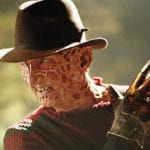 Movies and TV
Movies and TV  Movies and TV
Movies and TV  History
History 10 Things You Didn’t Know About the American National Anthem
 Technology
Technology Top 10 Everyday Tech Buzzwords That Hide a Darker Past
 Humans
Humans 10 Everyday Human Behaviors That Are Actually Survival Instincts
 Animals
Animals 10 Animals That Humiliated and Harmed Historical Leaders
 History
History 10 Most Influential Protests in Modern History
 Creepy
Creepy 10 More Representations of Death from Myth, Legend, and Folktale
 Technology
Technology 10 Scientific Breakthroughs of 2025 That’ll Change Everything
 Our World
Our World 10 Ways Icelandic Culture Makes Other Countries Look Boring
 Misconceptions
Misconceptions 10 Common Misconceptions About the Victorian Era
 Movies and TV
Movies and TV The 10 Coolest Stars to Set Sail on The Love Boat
 History
History 10 Things You Didn’t Know About the American National Anthem
 Technology
Technology Top 10 Everyday Tech Buzzwords That Hide a Darker Past
Who's Behind Listverse?

Jamie Frater
Head Editor
Jamie founded Listverse due to an insatiable desire to share fascinating, obscure, and bizarre facts. He has been a guest speaker on numerous national radio and television stations and is a five time published author.
More About Us Humans
Humans 10 Everyday Human Behaviors That Are Actually Survival Instincts
 Animals
Animals 10 Animals That Humiliated and Harmed Historical Leaders
 History
History 10 Most Influential Protests in Modern History
 Creepy
Creepy 10 More Representations of Death from Myth, Legend, and Folktale
 Technology
Technology 10 Scientific Breakthroughs of 2025 That’ll Change Everything
 Our World
Our World 10 Ways Icelandic Culture Makes Other Countries Look Boring
 Misconceptions
Misconceptions 10 Common Misconceptions About the Victorian Era
10 Historic Events That Are Creepier Than A Horror Movie
Normal history is already barbaric enough. Behind the wars, disease, and murders that everyone knows, are tales that find a way to be even more awful. Some of these terror-inspiring stories can only be compared to those in Halloween movies. But unlike horror movie monsters that can be defeated by saying “it’s just a movie,” the savage tales on this list are very real.
SEE ALSO: 10 Beloved Stories Based On Horrible True Events
10 The Astronaut’s Mysterious Visitor

In 2003, Yang Liwei was floating in his capsule. He had just made history as China’s first man in space. He was alone in a void. Then came a knock.
In space, nobody can hear you scream. But apparently you can hear tapping. Back on Earth, Liwei described the event to reporters. The sound reminded him of “someone knocking the body of the spaceship just as knocking an iron bucket with a wooden hammer.” He could not place the source of the sound. He said, “it neither came from outside nor inside the spaceship.” He set out to explore the shuttle for any hints. Starring out his porthole, he saw nothing noticeable on the side. There was nothing faulty inside either. No one could explain the eerie knock.
Scientist have had little success uncovering the sound’s mysterious origins when it came back. Theories about friendly aliens greeting Liwei to the neighborhood were quickly ruled out. Returning to Earth, Liwei inspected the capsule again. He and his coworkers were still stymied. The crew attempted to recreate the sound. Nothing came close. Because sound needs a medium, the most likely reason was an object physically hitting the spacecraft. No marks indicated outside contact. The most accepted theory is the metallic surface of the exterior contracted while exposed to the cold vacuum of space. Other astronauts have reported similar sounds in 2005 and 2008, lending credence that it has to do with the temperature. The truth is out there, but it’s probably just thermal change.[1]
9 The British Zombie Invasion

A virus breaks out. The shambling remains of the victims wander the city. The government tries to suppress them, but they escape. Armed locals have to take matters in to their own hands and execute them. This is the story of many zombie movies from REC to Resident Evil. For Black Plague victims in England, it was a reality.
As a burgeoning metropolitan center, London had reason to be particularly cautious about the spread of the disease. The ill were imprisoned in their own houses. To prevent visitors, the doors were padlocked. Any house holding the infected was marked with a red cross on the door to warn others to stay away. Armed guards were stationed to stop anyone from trying to help.
With minimal food and medicine, conditions broke down inside the house. Like George Romero’s Land of the Dead, the infected fought back. Families murdered the guards to escape. One common practice was to sneak a noose through a window and lower it until it hanged around the guard’s neck. With a quick jerk, the guard was hoisted up until he promised to let them go. Blankets were placed on top of murdered guards to trick plague carts in to dragging them off along with the dead. When whole streets were quarantined, neighbors rioted and massacred all the guards, with one crazed victim going so far as to manufacture homemade explosives.
Freedom was not worth all the bloodshed. The plague refugees wandered with no resources. As they fled London, many of the smaller villages barred entry. Locals threw stones and manure at the infirm. Some let the sick in, only to rob them.[2]
8 Waterloo Soldiers Were Ground Up To Fertilizer
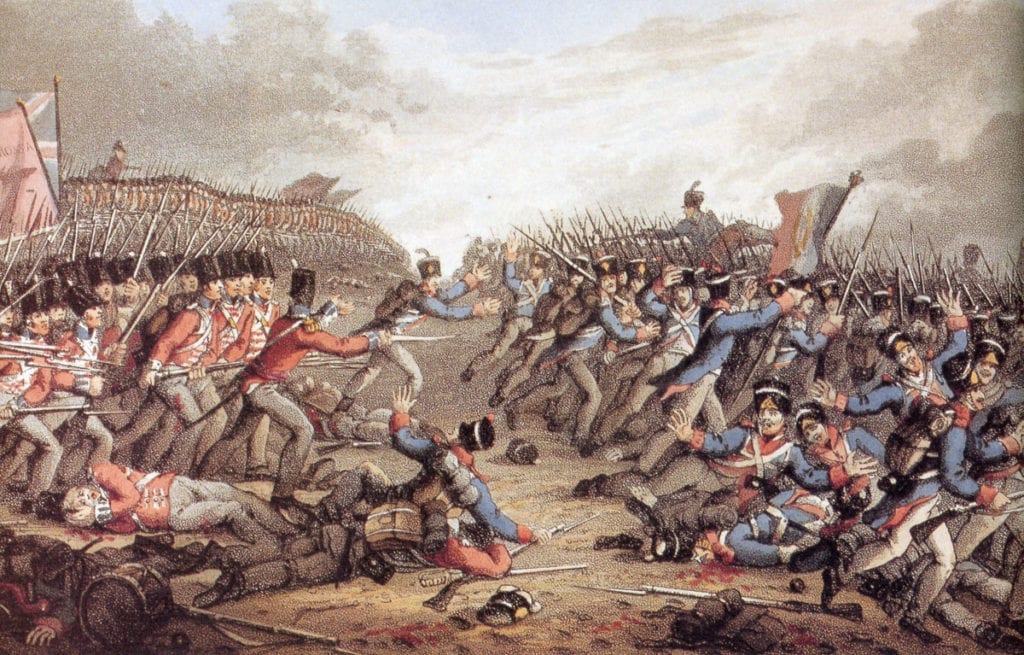
Between Napoleon Bonaparte and ABBA, Waterloo is synonymous with historical calamities. 60,000 soldiers died on that Belgian field. What those soldiers never would have guessed is that they would become a crucial part of English gardening.
A year after Waterloo, the fields were cleared. Companies collected all of the exposed soldier and horse bones. To maximize the space, they converted the bones into a powder. This practice was common on many of Napoleon’s other battlegrounds like Leipzig and Austerlitz.
Newspapers at the time report that in total they hauled, “more than a million bushels of human and inhuman bones.” The fallen French army were ground up in Yorkshire factories, marking their second defeat to the English. Putting the man in “manure”, the remains were mixed together as an additive in fertilizers. The oil from the marrow proved to be especially helpful, rivaling “almost any other substance.” With a positive spin on this wide-scale grave robbing, contemporary newspapers said “a dead soldier is a most valuable article of commerce.”
Sent in mass to Doncaster, the compound helped grow the plants in England’s agriculture center. Local farmers could buy it to help grow their own crops. A generation of Europeans ate food made with the help of dead bodies. Hannibal Lecter would have been proud . . . and satiated.[3]
7 Venerable Pope Pius XII’s Climatic Death
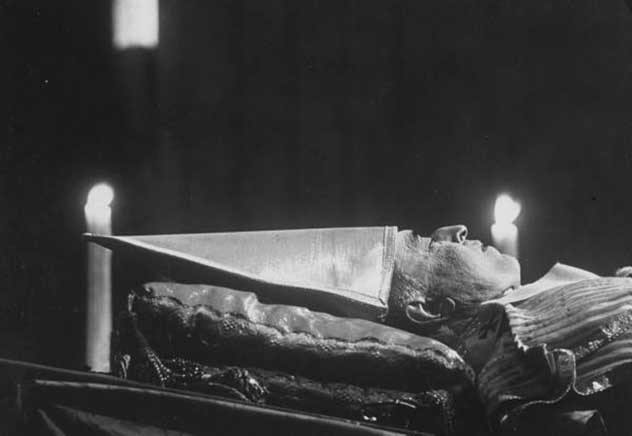
Venerable Pope Pius XII had one simple request. He did not want to be embalmed. He wanted his body to be interred as God had made it. Presumably, His Holiness did not want to explode either.
By his death in 1958, Pope Pius XII’s tenure had proven to be particularly controversial outside Catholic circles. Serving as the Pontiff in the buildup to and aftermath of World War II, historians have debated the merits of the Pope’s leadership. But those debates aside, the pontiff’s history suffered a final and disturbing blow. Papal Court doctor Galeazzi-Lisi got his position purely through nepotism. Friends with Pius XII (whilst still Cardinal Eugenio Pacelli) before he ascended to the papacy, Galeazzi-Lisi was woefully unqualified to be appointed as the Pope’s personal physician.
A quack with minimal medical training, Galeazzi-Lisi developed his own system of embalming. Evoking the oil rituals of early Christian leaders, Galeazzi-Lisi’s process of “aromatic osmosis” soaked the body in natural oils. For 24 hours, the body laid, wrapped in cellophane. There is a reason scientists abandoned this practice as it allows internal gases in the organs to build as the body decays. Stewing in the Mediterranean heat, the corpse burst open while being carried in procession.
After the corpse exploded, Galeazzi-Lisi was forced to re-embalm Pius overnight. It was too late. Pius XII’s nose and fingers had already flown off. Decomposition discolored the body. Displayed in St. Peter’s Basilica, mourners grieved over an “emerald green” corpse. Nearby guards fainted from the odor. Pius XII’s and Galeazzi-Lisi’s career were laid to rest the same day. Through ineptitude, he earned himself a place in history. He is the only person to have ever been banished from Vatican City.[4]
6 George Washington Comes Back From The Dead
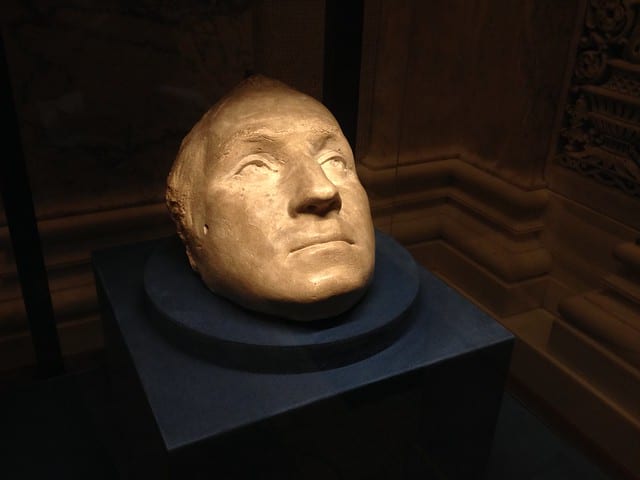
Before Dr. Victor Frankenstein, there was Dr. William Thornton. Frankenstein scrounged through the graves of recently executed criminals to create his unnatural monster. Thornton settled for more refined clientele, the Founding Father of the United States of America.
Martha Washington promised her husband George, that he would live to see the year 1800. George Washington died on Saturday night, December 14, 1799. Apparently unwilling to dishonor her promise, Martha contacted Dr. William Thornton.
George Washington was terrified of being buried alive. Terrible tales of coffins with scratch marks inside horrified him. With his secretary, Tobias Lear, Washington arranged to “not let his body be put into the Vault in less than three days” after confirming his death. During that window, his grieving family would sit around and wait to see if he moved. Thornton had another idea.
William Thornton was one of the most prestigious physicians of his time. Educated at Europe’s best schools, Thornton swore that he could cure everything wrong with Washington. Washington died before he arrived. That was no obstacle for Thornton. The plan was simple. Like a Thanksgiving turkey, Thornton would lower Washington’s body in cold water. To thaw him out, Thornton would swaddle the president in layers of blankets,. As Washington’s body temperature steadily increases, Thornton would pump air in his lungs to stimulate breath. To restart his heart, Thornton would inject the President with sheep’s blood. Eventually, the Washington would come back to life like nothing had ever happened. Surprisingly, the proposal was rejected. Grudgingly, Thornton believed for 20 years his experiment could have saved the President’s life. Science suggests otherwise.[5]
5 Ivan Pavlov experimented on homeless orphans too
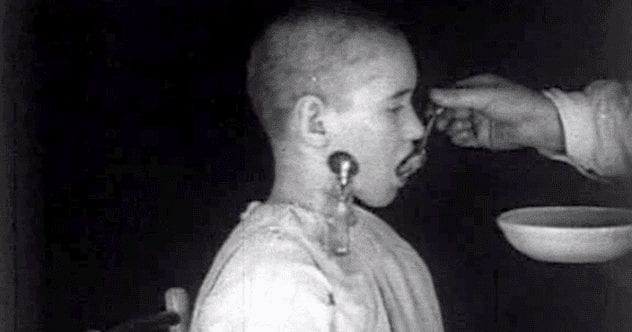
The mad Russian scientist’s mind control experiments on helpless victims is as classic a horror trope as they come. Those mad scientists do not usually get the Nobel Prize though. Ivan Pavlov is the exception that proves the rule.
Though Pavlov is most famous for conditioning dogs, that is not where his experiments were destined to end. A pupil of Pavlov, Nikolai Krasnogorsky, extended his experiments to humans. Acquiring subjects from the local orphanage, he had a group of young children he could easily manipulate without the burden of getting any clearance from their parents.
Repeating the set-up from his mentor’s famous dog experiments would have been impossible. Human beings are less willing than dogs to eat on cue. Bound with leather straps and metal head gear, the children’s mouths were locked open. Devices hooked inside the mouth measured their pooled saliva. An electronic pad hit their wrist whenever food was about to be distributed. The kids were force-fed both cookies and foul food. Their reactions to the different samples were recorded.
Though highly unethical, the research furthered the scientific understanding of conditioning on humans. Unlike Pavlov’s dogs, humans were less susceptible to slight changes in the stimuli. Through their suffering Kransngorsky’s children laid the groundwork for the modern theory of cognitive behavioral therapy.[6]
4 Minik Wallace’s Museum of Horrors
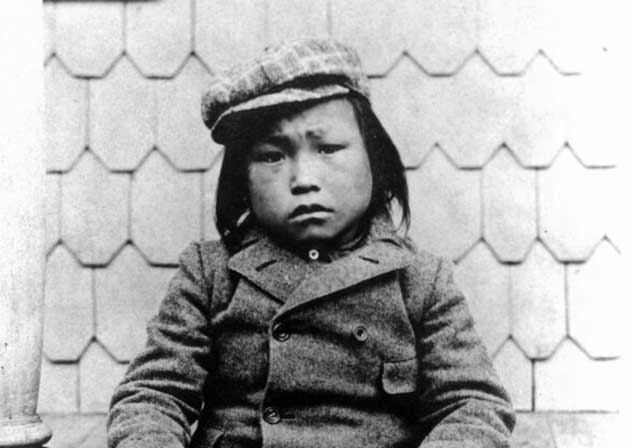
Robert Peary is best known today for his excursions to the North Pole in 1909. By that time, Peary and his crew had already spent years researching the Arctic. In September 1897, he sailed to New York accompanied, likely unwillingly, by six Eskimos from Greenland. The American Museum of Natural History was scheduled to perform physicals on them. Among the six were Minik, a 7-year-old boy, and his father, Qisuk.
Living as an attraction, visitors gawked at Minik and Qisuk in the Arctic exhibit. Unaccustomed to the germs in New York, four, including Qisuk, promptly died. Another left for the Arctic shortly after. Hundreds of miles from home, Minik Wallace was left alone. The museum threw Qisuk a funeral. Minik watched as his father was put to rest in the museum’s garden. In reality, the museum just buried a log wrapped with fur. Qisuk’s real body, along with the three other Eskimos, were dissected and bleached at Bellevue Hospital. Just a few feet away from Minik’s own exhibit, his father’s corpse was put on display.
This was Peary’s common practice. He robbed Eskimo graves for their bones and property. The Museum would buy it. For years, Minik campaigned for the return of his father’s body. His requests were refused until Minik finally got Peary to listen by threatening to reveal that Peary had fathered two Eskimo children. Peary let Minik return to the Arctic.
Minik’s return was bitter sweet. He relearned his native language and married a fellow Eskimo. However, as the only country he ever truly knew, he longed for the United States and returned. In 1916, working as a lumberjack in Pittsburg, N.H. Minik died in the Spanish Flu epidemic. He was 28.[7]
3 John Scott Harrison’s Cadaver Chop Shop

John Scott Harrison has the rare distinction of being the only person to be the son of a past United States president (William Henry Harrison) and the father of a future president (Benjamin Harrison). He also has the rare distinction of being a victim of a Leatherface-like dissection chamber.
As a onetime Ohio congressman, John Scott Harrison’s own tenure in politics was very successful, which explains why so many people attended his funeral on May 25, 1878. During the ceremony, mourners noticed that somebody had robbed the nearby grave of Augustus Devin. Worried that John Harrison might have the same fate, his sons placed three large stones bound with cement on the casket. It took 16 men to lift the stones. As a further precaution, a guard was hired to stand watch for a month.
Curious as to the fate of Mr Devin and suspicious of the nearby medical school’s need for corpses to study, a search warrant was obtained for the Medical College of Ohio. Their search uncovered multiple macabre finds including a box of mangled body parts and the splayed corpse of a six month old baby. But more revolting still was a masked naked corpse hanging from a rope. They removed the mask revealing the face of John Scott Harrison. His body had been robbed less than 24 hours after his burial . . . despite all of the precautions.
But what of Augustus Devin? He was later discovered pickling in a barrel at the University of Michigan.[8]
2 The Serial Killer in the London Blitz

The London Blitz was a time when England boldly stood against the steady march of Nazism. Daily life in bomb-rattled London was a constant struggle. Gordon Frederick Cummins only made it worse.
In the cover of compulsory darkness, Gordon Frederick Cummins terrorized London in a six-day spree of murder and assault. A total of seven women were attacked. Four of them died. Cummins, who had enlisted in the Royal Air Force, was stationed at the Aircraft Reception Centre in northern London. Mainly attacking prostitutes, the city became his hunting ground for a week.
His first victim Evelyn Hamilton was sexually assaulted, robbed, strangled, and discarded in a gutter. Barely twenty-four hours later, Evelyn Oately’s slashed body was discovered. Next to her disfigured corpse was a can opener used in the attack. A fingerprint on the can opener’s handle was recovered. The next day, Margaret Florence Lowe’s body was found with her organs ripped out of her abdomen. And then, for the fourth day in a row, police found another dead prostitute, Doris Jouannet.
To become a horror cliché, Cummins waited a day to attack on Friday the 13th. Unlike Jason Voorhees, Cummins did not kill anyone that night. 32-year-old Mary Haywood was saved when a night porter shone his flashlight on Cummins in the middle of an attack. During the scuffle, Cummins left his service respirator behind as he fled. The police traced the serial number back to Cummins. Matching Cummins’ prints to the one on the can opener, Cummins was sentenced to death. The newly dubbed “Blackout Ripper” was executed on the 25th of June, 1942.[9]
1 The Lincoln Assassination’s Forgotten Victim
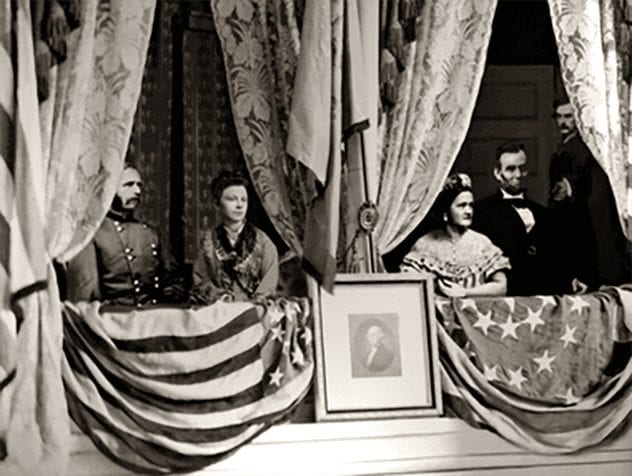
The Lincoln assassination was one of the saddest events in United States history. High-ranking members of the American government including Vice President Andrew Johnson and Secretary of State William Seward were targeted that night by Booth’s co-conspirators. One unintended victim intended was not: Clara Harris. A tangential involvement with the Lincoln assassination led to her death too.
Clara Harris was not even supposed to be at Ford’s Theatre that April night in 1865. She and her then beau major Henry Rathbone attended at First Lady Mary Todd Lincoln’s request. Following the recent victory of the Civil War, the theatre-goers were in a celebratory mood. But, as history well knows, the celebration was cut short when John Wilkes Booth barged into the president’s box and shot him in the head. Trying to apprehend the assassin, Rathbone grabbed Boothe’s arm but Booth stabbed him. With the bloody dagger still in hand, Booth escaped.
Years later, Clara Harris and Henry Rathbone married. Unable to part with her blood-stained dress, Clara had preserved it behind a walled off closet. She believed it might summon Lincoln’s ghost. Spirits talked to Rathbone too. Guilt driven for not stopping the tragedy, Rathbone heard voices in the walls. They blamed him for Lincoln’s death and ordered him to avenge the fallen president. With a murder straight out of The Shining, Rathbone recreated the assassination on Christmas Eve in 1883. He shot Clara and stabbed himself with a knife. Clara died. He then attempted to attack his children before groundskeepers could pull him off. Henry spent the rest of his life in an asylum.[10]
For more creepy stories like these ones, have a read of 10 Horror Stories That Intersected With Real Life In Frightening Ways, and 10 Creepy And Outrageous Urban Legends That Turned Out To Be Completely True.

